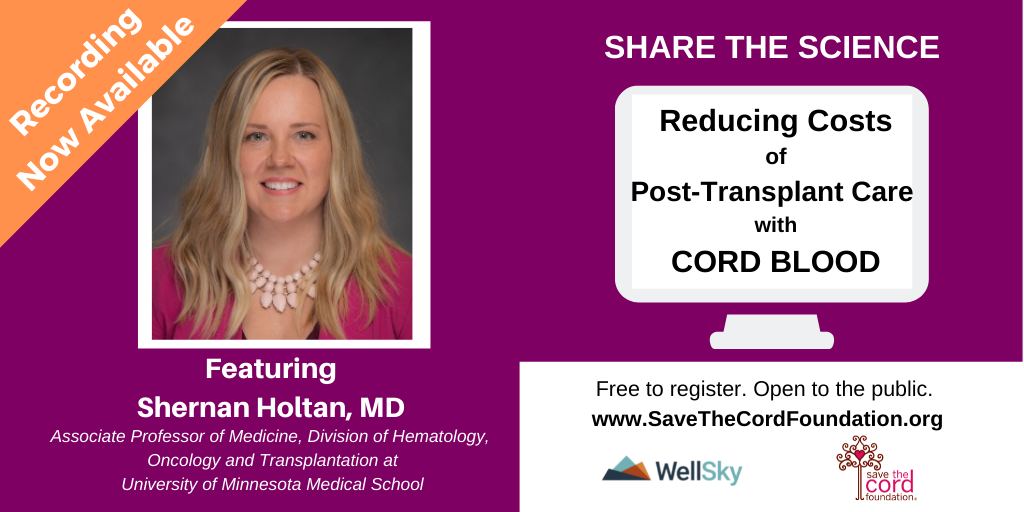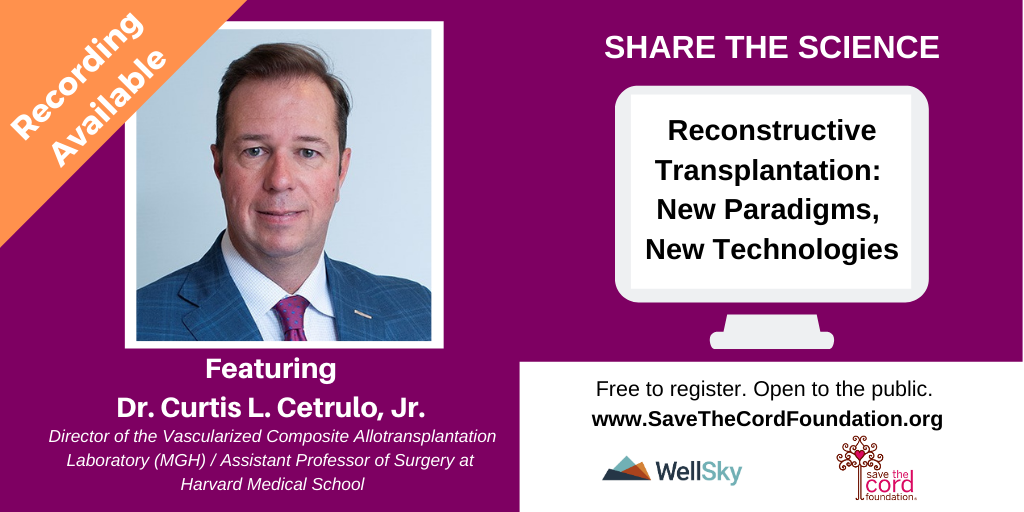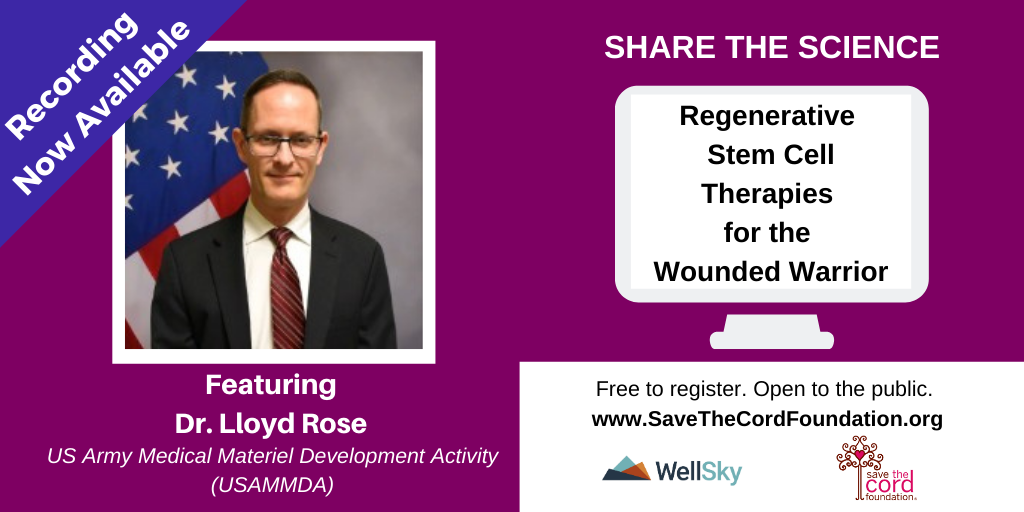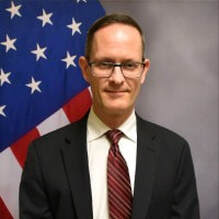|
Save the Cord Foundation and WellSky are proud to welcome Dr. Shernan Holtan, as our featured speaker for our next edition of Share the Science on May 20th, 2021 2pm ET / 11am PT. Join us to hear Dr. Holtan discuss the potential costs of healthcare long-term for cord blood transplant recipients. Share the Science is a free webinar series focused on the cord blood industry and the latest research in this field. As always, we invite both health professionals and the general public to join us for this unique online educational series. Learn more about this exciting educational series here. RECORDING NOW AVAILABLE. Cord blood transplants cheaper long term?Discover how umbilical cord blood may reduce the visits, lab studies, and medications required after hematopoietic stem cell transplants. Recipients of allogeneic hematopoietic cell transplantation (HCT) require substantial follow-up care after transplant. Now, data from 1,077 consecutive adult allogeneic HCT recipients at the University of Minnesota Medical School suggest that HCTs involving umbilical cord blood (UCB) had the lowest overall health care burden in the five years after transplant. The study also looked at HCTs with peripheral blood stem cells and bone marrow. The recipients of UCB had a lower long-term health care burden as measured by the number of:
SHARE THE SCIENCE with Shernan Holtan, MD Associate Professor of Medicine in the Division of Hematology, Oncology, and Transplantation - University of Minnesota Medical School "Reducing the Costs of Post-Transplant Care with Cord Blood" Free webinar. Open to the public. Thursday, May 20th at 2 pm ET / 11am PT RECORDING NOW AVAILABLE About the speaker
We wish to thank Dr. Shernan Holtan for volunteering her time to speak on
Share the Science and sharing her valuable insight on the cost of healthcare for stem cell transplant recipients. We also wish to also thank our generous sponsor and partner for this event, WellSky Health, who continue to support cord blood education through our “Share the Science” series. Save the Cord Foundation and WellSky are proud to welcome Dr. Curtis Cetrulo, Jr., as our featured speaker for our next edition of Share the Science on January 28th, 2021. Join us to hear Dr. Cetrulo present his amazing research regarding the use of hematopoietic stem cells in revolutionary reconstructive penis transplants. RECORDING NOW AVAILABLE. Share the Science is a free webinar series focused on the cord blood industry and the latest research in this field. As always, we invite both health professionals and the general public to join us for this unique online educational series. Learn more about this exciting educational series here. ***Please be advised that this webinar will contain some graphic images. While these are presented in a purely educational context, we would not recommend this webinar to young or sensitive viewers.*** Stem Cells: Use in Reconstructive TransplantationWhat role do stem cells have in reconstructive transplants? Vascularized composite allografts (VCAs) — transplants of the face, hand, and other extremities – offer great hope for those experiencing amputation, traumatic injury, or disfiguring disease. One obstacle to these procedures is the rejection of multiple tissue types from unrelated doors. Learn how hematopoietic stem cells (HSCs) play a vital role as part of a broader immunosuppression approach that allows transplants of composite tissue types from unrelated donors to overcome rejection. Dr. Curtis Cetrulo practices cutting-edge adult and pediatric reconstructive microsurgery, as well as hand surgery, breast and burn reconstruction, and reconstruction of extremities and traumatic facial injuries. He presents numerous inspirational examples of how VCAs are changing lives. How has the use of HSCs changed lives? Dr. Cetrulo will present numerous examples from his work of how the use of HSCs has improved patient outcomes. Some of these cases have also been highlighted in the national media. The New York Times featured Dr. Cetrulo and his team in 2016 when they performed the world's first ever penis transplant. In 2019, The LA Times featured a series of articles highlighting Dr. Cetrulo and his team following a penis transplant performed on a soldier who had been injured by a roadside bomb in Afghanistan. Clearly, we still have much to learn about the use of HSCs in reconstructive transplants but thanks to Dr. Cetrulo's work we can see infinite possiblities for the use of these powerful stem cells. This is research which builds on the world of cord blood research and the use of cord blood stem cells in regenerative medicine. Understanding Dr. Cetrulo's work is key to this emerging field. SHARE THE SCIENCE with Curtis L. Cetrulo, Jr., M.D., FACS Director of Vascularized Composite Allotransplantation Laboratory at Massachusetts General Hospital (MGH) and Assistant Professor of Surgery at Harvard Medical School "Reconstructive Transplantation: New Paradigms, New Technologies" Free webinar (pre-recorded). Open to the public. Thursday, January 28th - 2 pm Eastern Time/ 11 am Pacific Time This session was originally presented at WellSky’s CareForum Client Conference, and will now be rebroadcast as part of our Share the Science series in conjunction with Save the Cord Foundation. About the speaker
We wish to thank Dr. Curtis Cetrulo for volunteering his time to speak on
Share the Science and sharing his valuable insight on using HSC's for reconstructive transplantation. We also wish to also thank our generous sponsor and partner for this event, WellSky Health, who continue to support cord blood education through our “Share the Science” series. Share the Science: Regenerative Stem Cell Therapies for the Wounded Warrior - Dr. Lloyd Rose10/8/2020
Save the Cord Foundation and WellSky are proud to welcome Dr. Lloyd Rose of US Army Medical Material Development Activity, as our featured speaker for our next edition of Share the Science on October 22nd, 2020. Join us to hear Dr. Rose present his research regarding regenerative stem cell therapies and how the US Department of Defense is harnessing this research to help injured soldiers. Recording now available . Click here to view. Share the Science is a free webinar series focused on the cord blood industry and the latest research in this field. As always, we invite both health professionals and the general public to join us for this unique online educational series. Learn more about this exciting educational series here. Department of Defense Harnessing Stem Cell TherapiesThe last two decades have seen great improvement in our ability to keep traumatically injured soldiers alive from wounds that previously would have proven fatal. However, the result has been an increase in severe functional deficits due to loss of tissue and limbs. Harnessing stem cell therapies to regenerate lost or damaged tissue holds out hope for restoring our Wounded Warriors to full functionality and improving their quality of life.
Register now to discover some of the extraordinary work the DoD is doing in cell therapy and regenerative medicine to address traumatic injuries, especially those suffered by Military personnel. SHARE THE SCIENCE with Lloyd Rose, PhD Regenerative Medicine Portfolio Manager, Clinical and Rehabilitative Medicine Research Program US Army Medical Material Development Activity "Stem Cell Therapies for the Wounded Warrior" Free webinar. Open to the public. Thursday, October 22nd - 2pm Eastern Time/ 11am Pacific Time CLICK HERE TO WATCH THE RECORDING About the speaker
We wish to thank Dr. Lloyd Rose for volunteering his time to speak on
Share the Science and sharing his valuable insight on regenerative stem cell therapies for injured soldiers. We also wish to also thank our generous sponsor and partner for this event, WellSky Health, who continue to support cord blood education through our “Share the Science” series. |
AuthorWrite something about yourself. No need to be fancy, just an overview. Archives
December 2023
Categories |













 RSS Feed
RSS Feed


